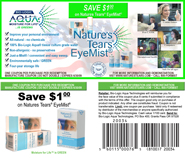Dry Eye
Eye Care News

Press Release
Dry Eye
Dry Eye Causes.
The world is attacking your eyes.Basic processes.
Two basic processes can result in dry eye symptoms:- Poor tear production (tears are produced in the eyes' "lachrymal glands"), as a result of disease, injury, physical deterioration or other factors.
- Excessive evaporation of the tear film's water component. Evaporation may be caused by:
- Environmental factors (dry air, air pollution, wind, etc.).
- Decreased production of lipids from the eyelids' meibomian glands (lipids form a layer over the tear film surface that lubricates, refracts light and slows water evaporation).
- A combination of environmental and physical factors.
Physical causes
Many of the following "dry eye triggers" are linked to systemic dehydration (not enough water in the body), which can often be alleviated simply by drinking more water every day and avoiding dehydrating substances such as alcohol, tobacco and strong narcotics.- Insufficient tear production. Reduced lachrymal gland tear production is especially common in …
- People over 50
- Post-menopausal women
- Post-LASIK patients
- People experiencing hormonal fluctuations
- Associated diseases:
- Diabetes
- Arthritis
- Autoimmune diseases
- Lupus
- Sjogren's syndrome
- Scleroderma
- Flu
- Allergies
- Many others
- Associated medications
- Blood pressure
- Antihistamines
- Decongestants
- Antidepressants
- Ibuprofen
- Many others
- Impaired lipid production. Tear film lipids are produced in tiny "meibomian" glands located in the eyelids. The glands can diminish in productivity or die due to age, injury, disease and/or a condition called "blepharitis,' or eyelid inflammation.
- Lipid underproduction and overproduction may both cause an increase in tear film evaporation. Too-thin lipid coverage can fail to hold aqueous layer water in place. Too-thick lipid coverage may become blotchy and uneven, with the same result.
Environmental causes:
Dry eye as a global health crisis is rapidly increasing, even where good medical care is available. In developing countries, blindness related to environmental factors such as dry and polluted air and inadequate water, is rapidly increasing and 80% preventable.
If the eye's immediate environment (the air surrounding the eye) has a relative humidity greater than 70%, the tear film has the ability to increase its moisture content by drawing water from the air. If the eye immediate environment has a relative humidity below 70%, the tear film will tend to lose water to evaporation and dry eye symptoms could result.
The tear film is more likely to lose water to evaporation if:
- The lipid layer, which helps seal in tear film moisture, is impaired.
- The air is polluted, since polluted air, regardless of humidity, has the same effect on the eyes as dry air.
- Other environmental factors that can effect tear film hydration:
- Temperature extremes (hot and cold)
- Wind
- Solar radiation
- Air pollution (including chemicals, particulate matter, dust, sand and smoke)
- Perspiration into the eyes
- Stagnant air
- Forced-air heating and cooling
- Insulated walls and windows
- Household chemicals
- Crowding
- Stress
- Computer use (when deeply engrossed, your eyes' blink rate can drop from 20 times a minute to three times a minute).
- Fluorescent lighting
- Airline cabins (If the low humidity doesn't dry your eyes and skin, the bacteria in the re-circulated air will).
- Riding in trucks or automobiles, especially with the heat or air on.
Related articles and sources
- "Dry Eye and Dry Air" (5-2-11, Bio-Logic Aqua Research)
- "Dry Eye and Our Changing Environment" (Sharon Kleyne Hour, 6-1-09, Marguerite McDonald, MD)
- "Dry Eye Causes" (4-29-11, Bio-Logic Aqua Research)
- Dry Eye Hot Spots in the US (Sharon Kleyne Hour, 9-29-08, Beth Battaglino, Cahill)
- Dry Eye Syndrome among Women (Sharon Kleyne Hour, 6-17-10 Ilene Gipson, MD) Global Dehydration Crisis (Sharon Kleyne Hour, 10-8-07, Robert Latkany, MD)
- Menopause, Aging and Dry Eye (Sharon Kleyne Hour, 8-18-08, Laurie Barber, MD)
- What is the Eyelid? (2-16-11, Bio-Logic Aqua Research)









